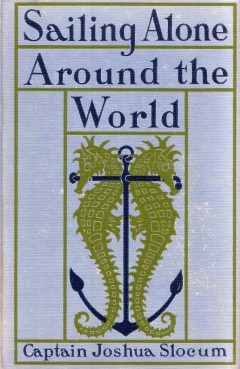Joshua Slocum (1844-1909)
Joshua Slocum was the first man to sail single-handedly around the world.
He was a Nova Scotian-born, naturalised American seaman and adventurer,
and a noted writer.
In 1900 he wrote a book about his journey
"Sailing Alone Around the World",
which became an international best-seller.
He disappeared on a voyage to the west indies in November 1909 while aboard his boat, the Spray.
In Fairhaven, Massachusetts, he rebuilt the 36′ (11 m) gaff rigged sloop named Spray.
On April 24, 1895, he set sail from Boston, Massachusetts.
After an extended visit to his boyhood home at Brier Island and visiting old haunts
on the coast of Nova Scotia, Slocum departed North America at Sambro Island Lighthouse
near Halifax, Nova Scotia on July 3, 1895, heading east.
Slocum intended to sail eastward around the world, using the Suez Canal, but when he got to Gibraltar
he realized that sailing through the southern Mediterranean would be too dangerous for a lone sailor
because of the piracy that still went on there at that time.
So he decided to sail westward, in the southern hemisphere.
He headed to Brazil, and then the Straits of Magellan.
At that point he was unable to start across the Pacific for forty days because of a storm.
Eventually he made his way to Australia, sailed north along the east coast,
crossed the Indian Ocean, rounded the Cape of Good Hope, and then headed back to North America.
Slocum navigated without a chronometer, instead relying on the traditional method of
dead reckoning for longitude, which required only a cheap tin clock for approximate time,
and noon-sun sights for latitude. On one long passage in the Pacific,
Slocum also famously shot a lunar distance observation, decades after these observations
had ceased to be commonly employed, which allowed him to check his longitude independently.
However, Slocum's primary method for finding longitude was still dead reckoning;
he recorded only one lunar observation during the entire circumnavigation.
Slocum normally sailed the Spray without touching the helm.
Due to the length of the sail plan relative to the hull, and the long keel, the Spray
was capable of self-steering (unlike faster modern craft), and he balanced it stably on any
course relative to the wind by adjusting or reefing the sails and by lashing the helm fast.
He sailed more that 1700 nautical miles west across the Pacific without once touching the helm.
More than three years after his departure, on June 27, 1898, he returned to Newport, Rhode Island,
having circumnavigated the world, traveling a distance of more than 40000 nautical miles.
In 1899 he published his account of the epic voyage in Sailing Alone Around the World,
first serialized in The Century Magazine and then in several book-length editions. |

|
|
